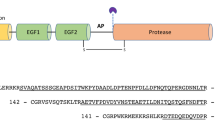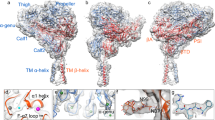Abstract
TISSUE factor is a cell-surface glycoprotein receptor which initiates the blood coagulation cascade after vessel injury by interacting with blood clotting factor VH/VIIa and which is implicated in various pathological processes1. When bound to tissue factor, factor VII is readily converted to the active protease factor Vila by trace amounts of factors Xa, IXa or Vila. Human tissue factor consists of 263 residues, the first 219 of which comprise the extracellular region2. We have determined the ocrystal structure of the extracellular region at a resolution of 2.2 Å. Tissue factor consists of two immunoglobulin-like domains associated through an extensive, novel, interdomain interface region. The binding site for factor VII lies at the interface region and involves residues from domain 1 and an extended loop (binding ‘finger’) of domain 2. This is the first reported structure of a representative of the class 2 cytokine receptor family, which also includes interferon-α, interferon-γ (refs 2, 3) and interleukin-10 (ref. 4) receptors.
This is a preview of subscription content, access via your institution
Access options
Subscribe to this journal
Receive 51 print issues and online access
$199.00 per year
only $3.90 per issue
Buy this article
- Purchase on Springer Link
- Instant access to full article PDF
Prices may be subject to local taxes which are calculated during checkout
Similar content being viewed by others
References
Ruf, W. & Edgington, T. S. FASEB J. 8, 385–390 (1994).
Edgington, T. S., Mackman, N., Brand, K. & Ruf, W. Thromb Haemostasis 66, 67–79 (1991).
Bazan, J. F. Proc. natn. Acad. Sci. U.S.A. 87, 6934–6938 (1991).
Ho, A. S. Y. et al. Proc. natn. Acad. Sci. U.S.A. 90, 11267–11271 (1993).
Boys, C. W. G. et al. J. molec. Biol. 234, 1263–1265 (1993).
Martin, D. M. A., O'Brien, D. P., Tuddenham, E. G. D. & Byfield, P. G. H. Biochemistry 32, 13949–13955 (1993).
O'Brien, D. P., Anderson, T. S., Martin, D. M. A., Byfield, P. G. H. & Tuddenham, E. G. D. Biochem. J. 292, 7–12 (1993).
Jones, E. Y. Curr. Opin. struct. Biol. 3, 846–852 (1993).
de Vos, A. M., Ultsch, M. & Kossiakoff, A. A. Science 255, 306–312 (1992).
Jones, E. Y., Davis, S. J., Williams, A. F., Harlos, K. & Stuart, D. I. Nature 360, 232–239 (1992).
Wang, J. et al. Nature 348, 411–418 (1990).
Ryu, S. E. et al. Nature 348, 419–426 (1990).
Brady, R. L. et al. Science 260, 979–983 (1993).
Bach, R., Konigsberg, W. H. & Nemerson, Y. Biochemistry 27, 4227–4231 (1988).
Rehemtulla, A., Ruf, W. & Edgington, T. S. J. biol. Chem. 266, 10294–10299 (1991).
Ruf, W., Schullek, J. R., Stone, M. J. & Edgington, T. S. Biochemistry 33, 1565–1572 (1994).
Roy, S., Hass, P. E., Bourell, J. H., Henzel, W. J. & Vehar, G. A. J. biol. Chem. 266, 22063–22066 (1991).
Ruf, W., Miles, D. J., Rehemtulla, A. & Edgington, T. S. J. biol. Chem. 267, 6375–6381 (1992).
Ruf, W., Miles, D. J., Rehemtulla, A. & Edgington, T. S. J. biol. Chem. 267, 22206–22210 (1992).
Gibbs, C. S., McCurdy, S. N., Leung, L. L. K. & Paborsky, L. R. Blood, Suppl. 1, 82, 451a, Abstr. 1788 (1993).
Paborsky, L. R. et al. Biochemistry 28, 8072–8077 (1989).
Sakabe, H. Nucl. Instrum. Meth. A 303, 448–463 (1991).
Otwinowski, Z. in Data Collection and Processing (eds Sawyer, L., Isaacs, N. & Bailey, S.) 56–62 (SERC Daresbury Laboratory, Warrington, 1993).
Otwinowski, Z. in Isomorphous Replacement and Anomalous Scattering (eds Wolf, W., Evans, P. R. & Leslie, A. G. W.) 80–85 (SERC Daresbury Laboratory, Warrington, 1991).
Holden, H. M. & Rayment, I. Archs Biochem. Biophys. 291, 187–194 (1991).
Jones, A. Meth. Enzym. 115, 157–171 (1985).
Brünger, A. T. X-PLOR, Version 3.1, A System for X-ray Crystallography and NMR (Yale Univ. Press, New Haven, 1992).
Kraulis, P. J. J. appl. Crystallogr. 24, 946–950 (1991).
Carson, M. J. appl. Crystallogr. 24, 958–961 (1991).
Author information
Authors and Affiliations
Rights and permissions
About this article
Cite this article
Harlos, K., Martin, D., O'Brien, D. et al. Crystal structure of the extracellular region of human tissue factor. Nature 370, 662–666 (1994). https://doi.org/10.1038/370662a0
Received:
Accepted:
Issue Date:
DOI: https://doi.org/10.1038/370662a0
This article is cited by
-
Characterization of the inhibition mechanism of a tissuefactor inhibiting single-chain variable fragment: a combined computational approach
Journal of Molecular Modeling (2020)
-
Recombinant tissue factor pathway inhibitor induces apoptosis in cultured rat mesangial cells via its Kunitz-3 domain and C-terminal through inhibiting PI3-kinase/Akt pathway
Apoptosis (2007)
-
Jak-Stat signal transduction pathway through the eyes of cytokine class II receptor complexes
Oncogene (2000)
-
Structure of the inhibitory receptor for human natural killer cells resembles haematopoietic receptors
Nature (1997)
Comments
By submitting a comment you agree to abide by our Terms and Community Guidelines. If you find something abusive or that does not comply with our terms or guidelines please flag it as inappropriate.



